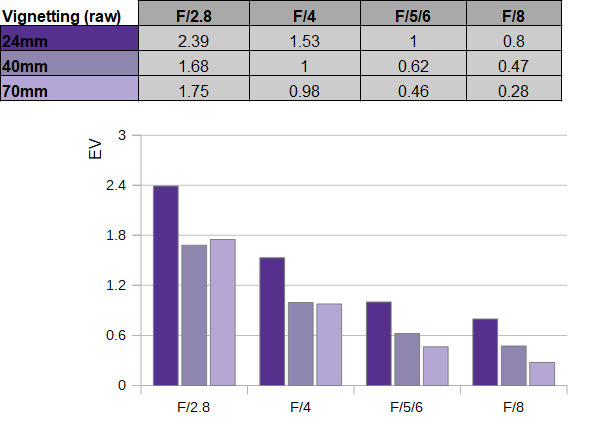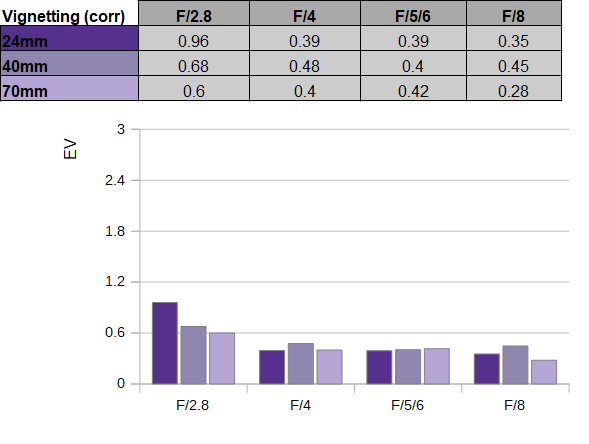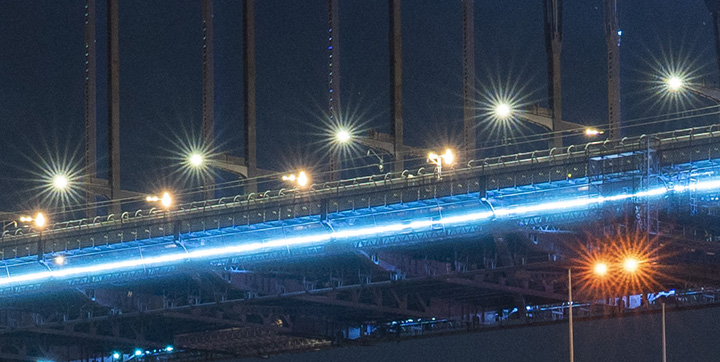|
Sony FE 24-70mm f/2.8 GM II - Review / Test Report - Analysis |
|
Lens Reviews -
Sony Alpha (Full Format)
|
|
Page 2 of 3

Distortion
The Sony FE 24-70mm f/2.8 GM II follows a fairly conventional distortion pattern for a fast standard zoom lens. At 24mm, there's a medium degree of barrel distortion (~2.5%). This turns into a negligible distortion around the 30mm mark before increasing to slight pincushion distortions at longer focal lengths with a peak of 1.6% at 70mm.
With activated image auto-correction, the distortions are almost perfectly corrected as you can see below.
Vignetting
The RAW vignetting is slightly better than average for a lens in this class. Needless to say but this still translates to a very heavy (2.4EV) light falloff at 24mm @ f/2.8. Stopping down helps but a moderate degree of vignetting remains even at f/8. The vignetting is somewhat lower at 40mm and 70mm at a fully open aperture and it's not a big issue anymore from f/5.6 onward.
 With activated image auto-correction this is reduced to just below 1EV (f-stop) at 24mm & maximum aperture. This can still be noticeable in certain scenes but it's acceptable. There's only slight vignetting at other settings.
With activated image auto-correction this is reduced to just below 1EV (f-stop) at 24mm & maximum aperture. This can still be noticeable in certain scenes but it's acceptable. There's only slight vignetting at other settings.

MTF (resolution)
The resolution characteristic of the Sony FE 24-70mm f/2.8 GM II has been substantially improved over its older cousin. At 24mm and 40mm, the lens is on prime lens level with an outstanding center quality and a very good outer image field. The broader center is superb at 70mm whereas there's a slight decline in the borders and corners. However, even so, the borders are good to very good at f/2.8 followed by good corners. Stopping down lifts the quality slightly with a peak at f/5.6. The borders are very good here and the corner quality is slightly elevated as well. Diffraction limits the center quality from f/8 onward but it remains very usable at f/11.
The field curvature is low. The centering quality of the tested sample was very good overall.
Please note that the MTF results are not directly comparable across the different systems!
Below is a simplified summary of the formal findings. The chart shows line widths per picture height (LW/PH) which can be taken as a measure of sharpness.
If you want to know more about the MTF50 figures you may check out the corresponding Imatest Explanations

Chromatic Aberrations (CAs)
Lateral CAs (color shadows at the image borders) are slightly elevated at 24mm with an average pixel width of ~1.5px at 24mm. The issue is negligible in the mid to long-range.
These CAs can be auto-corrected without a relevant loss in image quality so this is a lesser issue in real life.

Bokeh
If you invest in a fast standard zoom lens, you also invest in some (moderate) shallow depth-of-field capabilities so let's see what the Sony lens can do for us.
Out-of-focus highlights are quite nicely rendered. There's a slight outlining effect and a marginal nervousness in the inner zone. The (center-) highlight discs remain perfectly circular at f/4 and f/5.6 - surely thanks to the 11 rounded aperture blades that Sony has incorporated.
 The following samples illustrate the highlight rendering across the image field (taken around 70mm here). Circular highlights are maintained in a very broad zone before deteriorating in the far image corners where mechanical vignetting is taking its toll. Stopping down to f/4 results in an almost perfect rending across the whole image frame already.
The general rendition in the focus transition zones is almost perfect which is quite an achievement for such a complex standard zoom lens. The edge transitions are very smooth here.
The following samples illustrate the highlight rendering across the image field (taken around 70mm here). Circular highlights are maintained in a very broad zone before deteriorating in the far image corners where mechanical vignetting is taking its toll. Stopping down to f/4 results in an almost perfect rending across the whole image frame already.
The general rendition in the focus transition zones is almost perfect which is quite an achievement for such a complex standard zoom lens. The edge transitions are very smooth here.

Bokeh Fringing (LoCA)
The correction of axial CAs (LoCA) requires an apochromatic design and the Sony lens is not - like all other fast standard zoom lenses tested to date. In very shallow depth of field scenes, you may spot slightly color-tinted out-of-focus halos just beyond and in front of the focus zone. The effect is reduced at f/4 and gone by f/5.6.
Sun Stars
The Sony FE 24-70mm f/2.8 GM II can produce nice sunstars in the right conditions (stopped down to f/8+) as you can see below.

Flare
If we had to name a weakness of the Sony lens, it's flare. Keep in mind that you can push ALL lenses into producing freak effects. However, as you can see below, the Sony lens can produce some rather unpleasant ghostings and halos in extreme light situations. You won't take such a shot anyway but the issue can show up at times in less challenging conditions. On the positive side, there's comparatively little veiling glare.

|